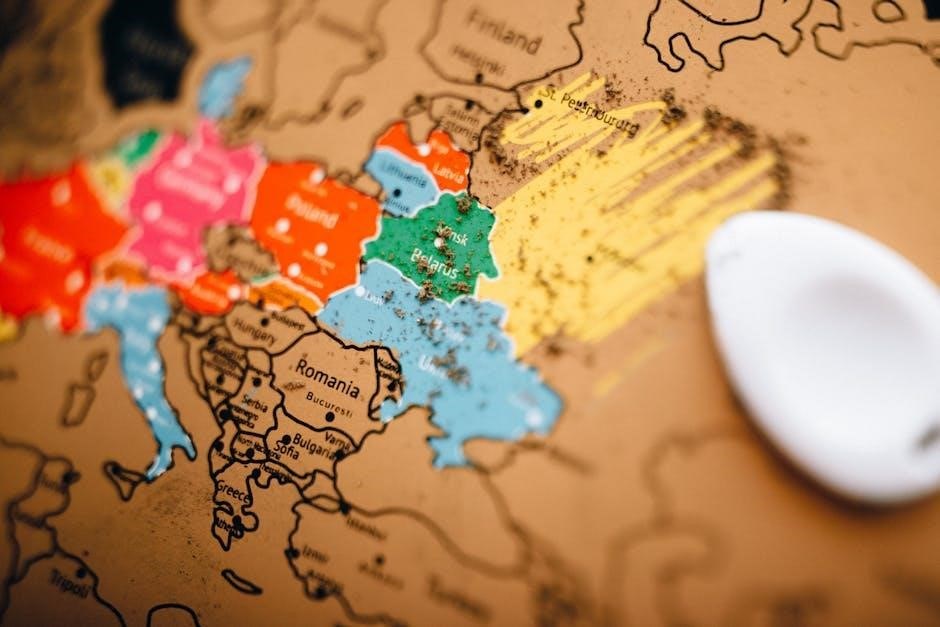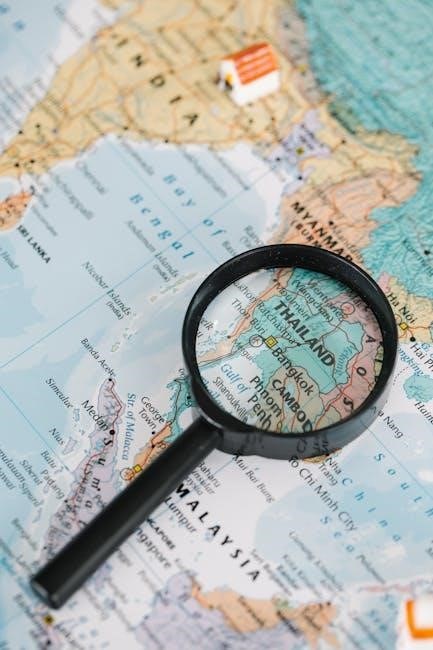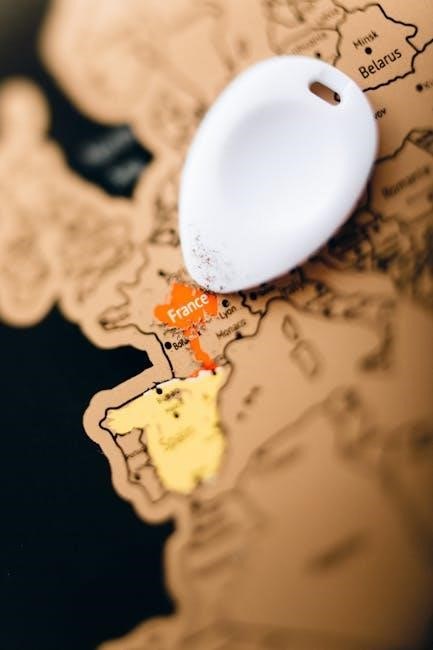NEETs, individuals not in education or employment, often find empowerment in parallel world narratives. These stories offer a stark contrast to their real-life challenges, fostering unique character growth and societal commentary.
Understanding NEETs: Definition and Relevance
NEETs (Not in Education, Employment, or Training) are individuals, often young adults, disconnected from societal structures. In the context of A NEET’s Guide to the Parallel World, Masamune Hidaka embodies this archetype, facing relentless bullying and societal alienation. His story highlights the struggles of NEETs, offering a unique lens to explore themes of isolation and redemption; By transitioning to a parallel world, Masamune, and others like him, find a fresh start, challenging the stigma attached to their status. This narrative not only provides escapism but also critiques societal expectations, making NEETs central to the story’s emotional and thematic depth. Their journey reflects broader issues of identity and resilience, resonating deeply with readers who feel marginalized or disconnected from mainstream society.
Parallel worlds in fiction serve as a compelling narrative device, allowing exploration of alternate realities and “what if” scenarios. These worlds often mirror our own, with slight yet significant differences, enabling authors to critique societal norms, experiment with alternate histories, or introduce fantastical elements. In A NEET’s Guide to the Parallel World, the concept is central, offering a fresh start for protagonists like Masamune Hidaka. This trope is particularly popular in fantasy and science fiction, providing a platform for character growth and thematic exploration. By immersing readers in unfamiliar yet relatable settings, parallel worlds challenge perceptions and spark curiosity. Their versatility makes them a staple in modern storytelling, blending escapism with deeper commentary on human experiences and societal structures.

The Protagonist’s Journey
Masamune Hidaka, a bullied NEET, transitions to a parallel world, becoming the weakest healer. Shunned initially, he rises to power, seeking revenge and redemption with determination and newfound allies.

Masamune Hidaka: Background and Motivations
Masamune Hidaka, a bullied high school student, struggles with relentless torment from his classmates. Driven to despair, he attempts suicide, only to be transported to a parallel world. Here, he is branded as a healer, the weakest class, and ostracized once more. His past trauma fuels his determination to rise above his circumstances and seek revenge against those who wronged him. Motivated by a desire for redemption and power, Masamune embraces his new role, leveraging his unique abilities to carve a path of vengeance and self-discovery. His journey is marked by resilience and a transformation from a victim to a formidable force, guided by the alliances he forges in this unforgiving new realm.
Transition to the Parallel World
Masamune Hidaka’s transition to the parallel world occurs after a dramatic suicide attempt, shifting his reality from despair to an unfamiliar realm. Alongside his classmates, he finds himself in a grand throne hall where a mysterious force assigns each individual a class. Despite his expectations of a powerful role, Masamune is designated as a healer, the weakest class, further isolating him. The transition sparks confusion and disbelief, as the group struggles to comprehend their new circumstances. The parallel world’s rigid class system and societal hierarchies immediately present challenges, particularly for Masamune, who must navigate this unfamiliar landscape with the stigma of his role. This abrupt shift sets the stage for his journey of self-discovery and transformation, driven by the harsh realities of his new environment.
Initial Challenges in the New Realm
Masamune and his classmates face immediate difficulties upon arriving in the parallel world. The rigid class system assigns roles based on unknown criteria, with Masamune being labeled a healer, a position viewed as weak and insignificant. This designation leads to ridicule and isolation, as his peers dismiss his abilities. The harsh realities of this new world quickly become apparent, with survival depending on one’s class and strength. Masamune must navigate a society where might determines worth, and his healer role places him at the bottom of the hierarchy. The initial challenges also include adapting to a world filled with magical and combat systems he barely understands. The mockery from his classmates and the pressures of this unforgiving environment push Masamune to question his value, setting the stage for his eventual growth and determination to prove his worth.

World-Building in the Parallel Realm
The parallel world is a meticulously crafted realm with a throne hall as its epicenter, where class assignments dictate power and status. Magical and combat systems reign supreme, blending strategy with raw strength, while diverse races like demons and the enigmatic White Cat Tribe shape the social fabric, creating a rich, immersive environment where survival hinges on adaptation and alliances;
The Throne Hall and Class Assignments
The throne hall serves as the central hub of power in the parallel world, where newly arrived students are assigned their classes. These assignments determine their roles, abilities, and social standing, creating a clear hierarchy. Masamune and his classmates are granted high-class jobs, with some becoming powerful warriors or mages, while others, like Masamune, are assigned less prestigious roles. The throne hall is a place of judgment, where one’s worth is immediately measured by their class. This system sets the stage for both cooperation and conflict, as individuals navigate their newfound abilities and the expectations tied to them. The throne hall’s grandeur and its rigid class assignments emphasize the stark contrast between this world and the one they left behind, highlighting the challenges of adapting to a reality governed by predetermined roles.
Magical and Combat Systems
The parallel world introduces a complex magical system where abilities are tied to class assignments. Magic is fueled by mana, with spells ranging from elemental attacks to healing. Combat is strategic, emphasizing skill synergy and class roles. Physical strength, agility, and magical prowess are key attributes, influencing battle outcomes. The system rewards mastery of abilities, allowing characters to grow stronger through experience and skill upgrades. Masamune, as a healer, faces unique challenges in this combat-centric world, relying on support skills and clever tactics to survive. The interplay between magic and combat creates a dynamic environment where adaptability is crucial. This system not only drives the story but also highlights the protagonist’s journey from weakness to power, showcasing the world’s depth and complexity.
Races and Factions: Demons and the White Cat Tribe
The parallel world is inhabited by diverse races, with demons and the White Cat Tribe being prominent factions. Demons are powerful beings with innate magical abilities, often feared by other races. The White Cat Tribe, known for their agility and wisdom, are mysterious and rarely form alliances. Both factions play crucial roles in shaping the world’s dynamics. Masamune’s journey introduces him to these races, revealing their complexities. The demons are not universally evil, and the White Cat Tribe harbors secrets. Their interactions with humans add depth to the narrative, exploring themes of prejudice and cooperation. These races and factions contribute to the rich tapestry of the parallel world, offering insights into its lore and societal structures.

The Role of the Healer Class
The Healer Class, often underestimated, plays a pivotal role in supporting allies and manipulating battle dynamics. Masamune’s journey transforms this perceived weakness into a unique strength, reshaping his destiny.
The Healer Class: Strengths and Weaknesses
The Healer Class, often dismissed as the weakest, possesses unique strengths that redefine its role in combat and strategy. Its ability to restore health and buffs makes it indispensable to any party. However, its lack of offensive capabilities and vulnerability in direct combat are significant drawbacks. Masamune, initially ridiculed for his Healer role, discovers hidden potential through creative use of his abilities. The Class’s true power lies in its versatility, allowing for strategic support and indirect influence on battles. Despite its limitations, the Healer Class becomes a cornerstone of Masamune’s growth, proving that even the most underestimated roles can reshape destiny. This duality of weakness and hidden strength makes the Healer Class a fascinating and pivotal element in the story.
Masamune’s Growth as a Healer
Masamune’s journey as a Healer begins with mockery and isolation, as his Class is deemed the weakest. Initially, he struggles with the stigma of being a Healer, facing ridicule and abandonment by his peers. However, through sheer determination and resourcefulness, he discovers the hidden potential of his Class. By mastering unique healing techniques and leveraging unconventional strategies, Masamune transforms his role from a liability to a game-changer. His growth is marked by creativity in combat, using his abilities to outwit foes and protect allies. Over time, he garners respect and recognition, proving that even the most underestimated roles can achieve greatness. This evolution showcases his resilience and ingenuity, turning his perceived weakness into a formidable strength. Masamune’s development as a Healer becomes a cornerstone of his revenge and redemption arc, highlighting the power of perseverance and adaptability.
Stigma and Perceptions of the Healer Role
The Healer Class in the parallel world is often viewed with disdain, seen as the weakest and least desirable role. Masamune, assigned to this Class, faces immediate ridicule and abandonment by his peers, who regard him as useless in combat. The stigma surrounding Healers is deeply ingrained, with many believing they are better off alone or in supportive roles. This perception isolates Masamune, forcing him to confront the harsh realities of his newfound identity. Despite his initial struggles, he begins to challenge these stereotypes by discovering innovative ways to utilize his abilities. Over time, his resilience and creativity start to shift the narrative, proving that even the most underestimated roles can hold extraordinary power. The stigma of being a Healer becomes a catalyst for Masamune’s growth, transforming him from an outcast into a pivotal figure in the story.

Companions and Allies
Masamune forms unlikely bonds with demons and the White Cat Tribe, who become his loyal companions, offering support and challenging the stereotypes of his perceived weakness as a Healer.
Key Companions and Their Roles
Masamune’s journey is enriched by the White Cat Tribe and powerful demon allies, who provide wisdom, strength, and unwavering loyalty. These companions not only aid him in battles but also challenge the societal stigma surrounding his role as a Healer. Their diverse skills and perspectives transform Masamune’s perception of his abilities, fostering growth and resilience. Together, they navigate the complexities of the parallel world, forging unbreakable bonds and redefining the notion of strength beyond traditional combat roles. These allies are instrumental in Masamune’s transformation from a bullied NEET to a formidable figure in this new realm.

The White Cat Tribe: Allies and Mentors
The White Cat Tribe emerges as crucial allies and mentors to Masamune, offering guidance and support in the parallel world. Their wisdom and magical prowess help him navigate the complexities of his new role as a healer. The tribe’s unique abilities and deep understanding of the realm’s dynamics make them invaluable mentors, challenging Masamune’s perceptions and enhancing his skills. Their loyalty and camaraderie provide a stark contrast to his isolating NEET life, fostering a sense of belonging and purpose. The White Cat Tribe’s influence is pivotal in shaping Masamune’s approach to challenges, emphasizing strategy and teamwork over brute force. Their mentorship not only bolsters his confidence but also redefines his identity in this new world.
Strategic Alliances and Team Dynamics
Masamune’s journey in the parallel world is deeply influenced by the strategic alliances he forms, shifting his role from an isolated NEET to a pivotal team leader. These alliances are forged with diverse races and factions, each bringing unique strengths to the table. The dynamics within these groups are complex, often requiring Masamune to navigate political and cultural differences. His ability to heal and strategize becomes a cornerstone of these alliances, fostering trust and cooperation. The interplay between characters highlights themes of unity and mutual growth, as Masamune learns to rely on others and lead effectively. These alliances not only enhance his combat prowess but also redefine his identity, transforming him into a unifying force in the new world. This evolution underscores the importance of collaboration in overcoming adversity.

Themes and Social Commentary
The story explores themes of bullying, revenge, and social hierarchies, offering a critique of societal pressures and isolation. It reflects on the struggles of marginalized individuals seeking redemption and acceptance.
Bullying and Its Aftermath
Masamune Hidaka’s ordeal with bullying drives the narrative, showcasing the profound emotional scars left by relentless harassment. His classmates’ cruelty pushes him to despair, culminating in a suicide attempt. This traumatic experience shapes his resolve for revenge, fueling his determination in the parallel world. The story vividly portrays the psychological toll of bullying, highlighting isolation and the struggle for redemption. Masamune’s journey reflects the lasting impact of such abuse, emphasizing the need for empathy and understanding in addressing societal issues like bullying.
Revenge as a Motivational Theme
Revenge emerges as a central driving force in Masamune’s journey, fueled by the torment he endured from bullying. His transition to the parallel world transforms this desire into a quest for power and redemption. The narrative explores how revenge evolves from a destructive impulse to a catalyst for personal growth. Masamune’s experiences highlight the complexity of vengeance, revealing its potential to both consume and transform. Through his struggles, the story delves into the psychological and moral implications of seeking revenge, ultimately showing how it shapes his identity and purpose in the new world. This theme resonates deeply, offering a nuanced portrayal of revenge as a multifaceted motivator.
Social Hierarchies in the Parallel World
The parallel world introduces a rigid social hierarchy shaped by class assignments and magical abilities. Upon arrival, students like Masamune are categorized into distinct roles, with healers often viewed as inferior. This structure mirrors real-world societal stratification, where power and status determine one’s place. The throne hall serves as a symbol of authority, reinforcing these divisions. Additionally, racial tensions between demons and the White Cat Tribe further complicate the hierarchy, creating layers of conflict and cooperation. Masamune’s journey challenges these norms, as his unexpected rise as a healer defies expectations and disrupts the established order. The narrative critiques systemic inequality while exploring how individuals navigate and transform such structures. This theme adds depth to the story, highlighting both the resilience of marginalized characters and the potential for change.

Character Development and Growth
Masamune evolves from a bullied victim to a resilient healer, navigating a parallel world’s challenges and transforming through newfound power and purpose.
Masamune’s Transformation: From Victim to Victor
Masamune’s journey from a bullied high school student to a powerful healer in a parallel world is a testament to his resilience and growth. Initially, he is ridiculed for his Healer class, seen as the weakest occupation. However, he discovers his abilities are far more potent than anyone imagined, making him the strongest in the new realm. This transformation not only changes his outlook on life but also fuels his determination to confront his past tormentors. Through his experiences, Masamune evolves from a despairing victim to a confident victor, embracing his new identity and forging alliances that aid him in his quest for revenge and redemption.
Supporting Character Arcs
The supporting characters in A NEET’s Guide to the Parallel World play pivotal roles in shaping Masamune’s journey and the story’s depth. Each companion, such as members of the White Cat Tribe and demon allies, brings unique abilities and perspectives. Their arcs explore themes of loyalty, redemption, and personal growth, complementing Masamune’s transformation. The White Cat Tribe, with their wisdom and guidance, help Masamune understand his potential, while demon characters, often misunderstood, find purpose in their alliance with him. These relationships foster trust and camaraderie, essential for overcoming challenges. The characters’ individual struggles and evolutions add layers to the narrative, highlighting the importance of teamwork and mutual respect. Their stories intertwine seamlessly, creating a rich tapestry that enhances the protagonist’s quest for revenge and self-discovery.

Plot Twists and Key Events
Masamune’s journey unfolds with thrilling developments, from his class transition to unexpected betrayals. The narrative explores his revenge quest, challenging moral dilemmas, and the true nature of the parallel realm.
The Journey of Revenge and Redemption
Masamune’s journey is a gripping tale of transformation, from a bullied victim to a powerful force in a parallel world. Initially driven by a desire for revenge against his tormentors, he discovers his true potential as a healer, challenging perceptions of weakness. With the support of companions like the White Cat Tribe and demon allies, he navigates a world of magic and combat, uncovering hidden strengths and confronting moral dilemmas. As he rises, his quest for vengeance evolves into a broader mission for redemption, blending personal growth with the fight against injustice. This arc highlights the complexity of revenge and the power of self-discovery in shaping destiny.
